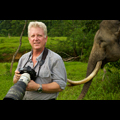Visit the exhibition
Discover the incredible stories of life on our planet through powerful photography and expert insight.
Tickets on sale now.

Los Angeles’ Griffith Park, site of the iconic Hollywood sign, is not where anyone expected to find a cougar.
But in March 2012, a trail camera set to monitor wildlife caught an image of a big male. Steve’s excitement was as great as that of the biologists. Working with them, he set up a series of camera traps in the hills around Los Angeles, each positioned so they might catch the cougar against the city background. But it took 14 months before everything finally came together – the posture, composition and lighting – and he got his dream shot, the ultimate urban cougar picture. Extremely adaptable, cougars are now recolonizing areas in the USA where they’ve been hunted out. To get to downtown Los Angeles, the male would have had to travel at least 32 kilometres (20 miles) from the nearest California cougar population and cross two of the busiest highways in the USA. He has plenty of food – hunting deer, coyotes and raccoons in the canyons at night – and he continues to hide from people in the day. But in a human-dominated environment, he faces other trials. In 2014, he had to be captured and treated for both mange and rat-poisoning, and cars remain a constant threat.
Discover the incredible stories of life on our planet through powerful photography and expert insight.
Tickets on sale now.

USA
Steve became a National Geographic photojournalist in 1991 and specialises in photographing big cats. He lectures on photography and conservation issues, selling out venues from the Sydney Opera House in Australia to the Roy Thompson Hall in Toronto, Canada. He won the grand prize for Wildlife Photographer of the Year in 2008.
Help us harness the power of photography to advance scientific knowledge, spread awareness of important issues and nurture a global love for nature.